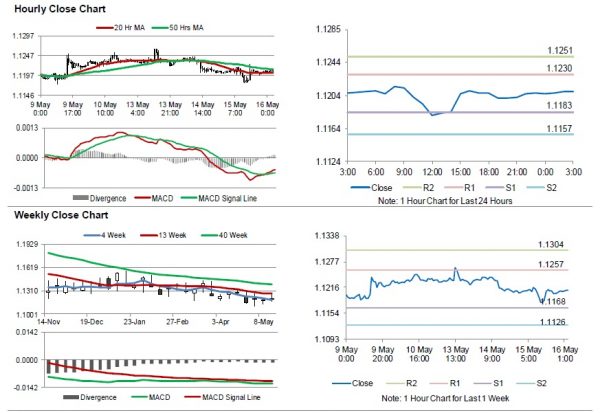For the 24 hours to 23:00 GMT, the EUR traded flat against the USD and closed at 1.1207.
On the macro front, the Euro-zone’s seasonally adjusted flash gross domestic product (GDP) rose 0.3% on a quarterly basis in 1Q 2019, less than market expectations for a rise of 0.4%. In the previous quarter, the GDP had recorded a rise of 0.4%.
Separately, in Germany, the seasonally adjusted flash gross domestic product (GDP) climbed 0.4% on a quarterly basis in 1Q 2019, in line with market expectations and compared to an unchanged reading in the previous quarter.
In the US, data indicated that the NY Empire State manufacturing index unexpectedly rose to a six-month high level of 17.8 in May, compared to market consensus for a fall to a level of 8.0. The index had registered a reading of 10.1 in the previous month. Moreover, the NAHB housing market index climbed to a level of 66.0 in May, notching a 7-month high level and following a level of 63.0 in the previous month. Market participants had anticipated the index to register a to rise to a level of 64.0.
On the other hand, the nation’s advance retail sales surprisingly fell 0.2% on a monthly basis in April, defying market expectations for an advance of 0.2%. In the previous month, advance retail sales had registered a revised rise of 1.7%. Further, the US industrial production unexpectedly declined 0.5% on a monthly basis in April, falling to its lowest level in two years amid decrease in demand for automobiles. In the preceding month, industrial production had recorded a revised climb of 0.2%, while market participants had expected for a steady reading. Additionally, the manufacturing (sic) production surprisingly slid 0.5% on a monthly basis in April, signalling a slowdown in the economy due to escalating US-China trade tensions and defying market consensus for an unchanged reading. Manufacturing production had recorded an unchanged reading in the previous month. Also, the MBA mortgage applications retreated to its lowest level in four months by 0.6% on a weekly basis in the week ended 10 May 2019, following an increase of 2.7% in the prior month.
In the Asian session, at GMT0300, the pair is trading at 1.1209, with the EUR trading a tad higher against the USD from yesterday’s close.
The pair is expected to find support at 1.1183, and a fall through could take it to the next support level of 1.1157. The pair is expected to find its first resistance at 1.1230, and a rise through could take it to the next resistance level of 1.1251.
Looking ahead, traders would keep an eye on the Euro-zone’s trade balance for March, set to release in a few hours. Later in the day, the US housing starts and building permits, both for April and the Philadelphia Fed business outlook for May along with initial jobless claims, will pique significant amount of investors’ attention.
The currency pair is trading above its 20 Hr moving average and showing convergence with its 50 Hr moving average.













